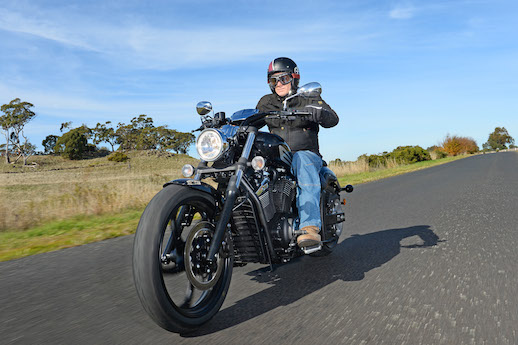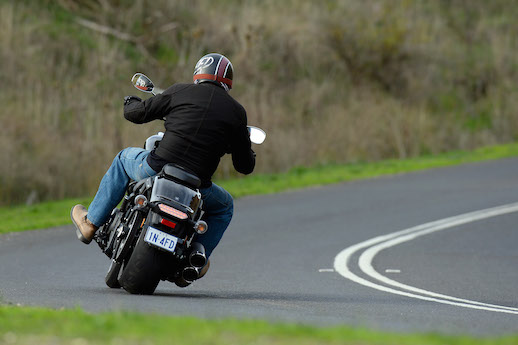The new Yamaha Stryker is the second in the comprehensive Star cruiser line-up to feature a modern, minimalist style, following on from the Bolt.
Yamaha calls it their “tattoo” look compared with the heritage style of the rest of the line-up. Yamaha Moto Australia marketing guru Sean Goldhawk aptly refers to the Bolt and Stryker as the Offspring in a reference to the heavily tattooed rock band.
The 950cc Bolt and 1300cc Stryker are the beginning of a raft of new Offspring models featuring less chrome, more gunmetal surfaces and a modern, minimalist look.
But while the Bolt is a blank canvas for young customisers to slice and dice, the new 1304cc Stryker rolls off the factory floor as a fully customised cruiser at $14,999 for the “raven” gloss black and $15,299 for the matte grey with tank graphics and the new Bullet Cowl in camo green for $15,599. That’s a very competitive price and it comes with an impressive five-year, unlimited-kilometre warranty like the rest of their cruisers.
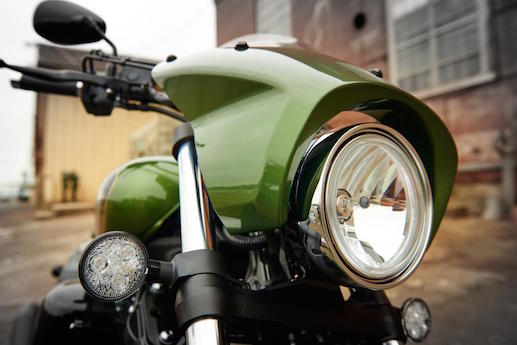
This positions it below the XVS1300A ($15,999) and XVS1300AT ($18,299) which were previously the pick of the bunch for their balance of weight, handling and performance.
Sean says the Stryker won’t replace the current XVS1300 models, but will be an addition to the fleet giving Yamaha more metric cruisers than any other Japanese manufacturer in Australia. Stryker brings the cruiser total up to an even dozen, one more than Suzuki and nearly twice as many as Honda or Kawasaki.
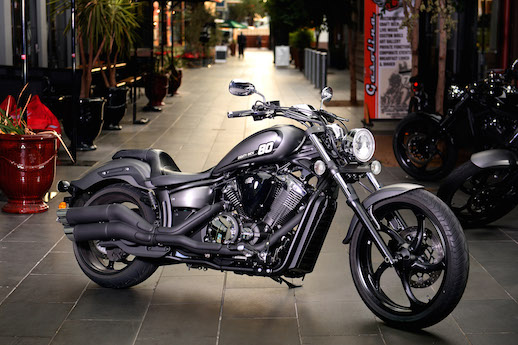
The aggressive-looking Stryker is powered by the same liquid-cooled 1304cc 60-degree V-twin, but the bike has a kicked-out chopper-style front end, less chrome, modern LED taillights and that minimalist “tattoo” look.
The engine has four valves per cylinder, delivers 100Nm at 3000 revs and loves to rev more than most cruiser engines. Even though it’s water-cooled it still has the traditional cooling fins and the blacked-out radiator is discretely tucked in between the cradle frame. It is driven by a low-maintenance and quiet belt drive. In fact, the whole drivetrain is very quiet, allowing the rider to enjoy the deep bass of the muted twin single-sided exhausts.
Beauty is in the eye of the beholder and the chopper look doesn’t particularly turn me on, but this mean and aggressive machine does turn your head, thanks to the extended forks and swirling 21-inch mag wheel. For the tech-heads, the forks have a 40-degree rake with 109mm of trail and a 34-degree caster.
That fork rake, skinny front tyre and 210mm rear tyre would indicate it will be slow to steer and will be prone to standing up in corners. However, as we shove off on the launch ride from motorcycle café, Gasolina on Melbourne’s Southbank, it quickly becomes evident that the steering geometry works.
It doesn’t flick around like a sportsbike, but the steering is lighter than expected. It’s not “light and nimble” as Yamaha suggests in its spiel, but it’s no barge, either.
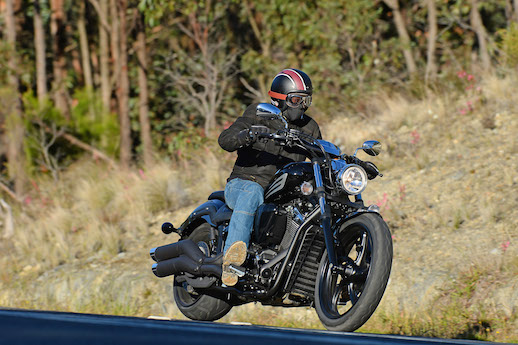
The flat and fat 1” bars are up on an extended riser so you punch the air like the Sons of Anarchy. The controls are conventional with a nice quality feel to match Yamaha’s typically impeccable build quality that features steel fenders on all Yamaha Star bikes.
A glaring anomaly here is the strange-shaped instrument panel surrounded by chrome-painted plastic. It looks out of place. Such a modern pod would be expected to be a modern unit with digital display, but it houses a large analogue speedo with a tiny LCD screen that shows odo, two trip metres, clock and fuel gauge, all of which I found difficult to read in any light conditions. Importantly, you can toggle between LCD displays via a switch on the bars, but it’s on the right rather than on the left where it should be.
There is no tacho, but I can tell you the gearing is very high. You will do most suburban corners in first gear and, on the highway, you will need to drop from fifth to fourth or even third for overtaking manoeuvres. There is no sixth gear on any Yamaha cruiser, but fifth feels overdriven anyway.
Gears are very positive and they don’t have that awful mechanical clunk as they engage that we expect from such a torquey drivetrain. Instead, they lock into place with an assuring thud. Neutral is relatively easy to find.
There is plenty of torque available in the lower reaches, but when you climb the revs, it really gets excited and rips your arms off.
Stopping isn’t great with a single disc up front which matches the stopping power of the rear brake. Together, they work quite well. There is also good feel from the lever and pedal. Sean says ABS is not offered because it adds $1000 to the price. “This is quite a price-sensitive market and there are not enough people worried about it,” he says.
Ride is firm with a hard-sprung rear shock that bounces me out of my seat on several occasions on the bumpy country Victorian roads. It even launched a few of my colleagues who weigh almost double, yet none of them reported the bike bottoming out. The front bump steers a bit and the fat rear tyre tracks on longitudinal cracks and ridges.
However, handling is pretty good and you can touch down the footpegs with confidence on most corners as it doesn’t wallow and there are no hero blobs underneath to dig into the tarmac.
Our launch ride included a couple of extended highway stunts that indicate you can ride reasonable distances before you start fidgeting in the saddle. Fuel stops will probably pull you up about the time you get saddle sore with 14 litres in the teardrop tank and a 2.2L reserve.
Then you can step back and admire the long and awesome machine, accept the praise of the trendy guy at the next fuel pump and compare tattoos.
Star Stryker XVS1300
- Price: $14,999 (black), $15,299 (grey), $15,599 (Bullet Cowl in camo green)
- Warranty: 5 years, unlimited km
- Engine: 1304cc liquid-cooled, 4-stroke, 4-valves, V-twin
- Bore x stroke: 100 x 83mm
- Compression: 9.5 : 1
- Transmission: 5-speed, belt drive, wet clutch
- Suspension: 41mm forks, 135mm travel, rear swingarm, 100mm travel
- Caster angle: 34º
- Trail: 109 mm
- Brakes: hydraulic 320/310mm single discs
- Tyres 120/70-21M/C 62H; 210/40R18M/C 73H (tubeless)
- Length: 2535mm
- Width: 860mm
- Height: 1130 mm
- Seat: 670mm
- Wheelbase: 1755mm
- Clearance: 150mm
- Wet weight: 293kg
- Fuel tank: 15 litres, 2.2L res
- Oil tank: 3.7 litres


